
Landscape with Mountain Lake, Morning by Caspar David Friedrich (19th c).
Kiora's Dambreaker by Matthias Kollros.
As we roll into the Summer of 2019, Commander and other Magic formats are faced with another change to its mulligan rules. A few years back we had used the "Partial Paris" mulligan rule, and when the rest of Magic switched over to the "Vancouver" mulligan, the Commander rules committee in their infinite wisdom decided that we should have the same mulligan rules as every other major format. If a new player was going to come try out Commander it just made more sense for them to be able to jump right in and have one less thing to be confused about.
The Partial Paris mulligan allowed players to shuffle away part of their opening hand and draw that number of cards minus one. This allowed for players to dig for combo pieces very effectively and was eventually replaced by the Vancouver mulligan. Vancouver has us muliganning by drawing seven cards minus one for each time we have muliganned after we've used our free mulligan. In both of these mulligan types we had a clear indication of how many cards we are supposed to be drawing each time because we had a clue right in our hands. If I had just drawn five cards, I knew that my next mulligan would be down to four cards.
With the London Mulligan almost upon us, and probably already in use by some players, I began this piece wanting to write about... dice.
Why write about dice?
Dice are an essential tool in keeping track of things in Magic that are easily forgotten. Without a clue in our hands as to how many cards we are to draw, I can easily see players losing track of where they are in their mulligan process. Dice help us in many, many ways, so today I'm going to share how I use them to represent my board state. I try to make sure my tablemates know exactly what's going on with my battlefield at all times and I use a lot of dice to do that.
This is going to be a meandering piece that will look at ways you can make your board state clear and easy to understand. It starts with dice, but I'll discuss creature tokens at the end for good measure. With any luck, there will be something in here that you can incorporate into your game to help make sure your battlefield is a little clearer and easier to understand too.
The London Mulligan
We used to have an indication of how many cards we were supposed to draw for each mulligan by the number of cards we had in our hand. Now with the London Mulligan we will draw seven cards each time and put an extra card on the bottom of our library for each mulligan we've taken.
We draw seven. If we don't like it, we shuffle them away, and...
... draw seven because in multiplayer we get a free mulligan. If we don't like those, we shuffle them away and...
... draw seven. We then put one card on the bottom of our library and if we don't like our hand, we shuffle it away and...
... draw seven. We put TWO cards on the bottom of the library, and if we don't like our hand, we continue to mulligan putting an additional card on the bottom of the library each time.
Players will quite reasonably want to shortcut the process of putting cards onto the bottom of the library. If you're going to shuffle away your hand anyways, you might as well get on with the process and try to get to your final starting hand more quickly.
Ideally every player will be able to remember how many mulligans they are on and will always execute this new mulligan process with no problems. In the real world, people get interrupted and distracted by other players and by things happening around them and folks will occasionally lose track of where they are in the process of doing mulligans.
Fortunately, there's an easy solution at hand - just use a six-sided die to keep track of how many cards you need to put on the bottom of the library.
You probably have dice lying around even if you're not running a deck that will need them, and there is real value in having a way to show to your opponent that you're tracking your mulligans. They'll have fewer concerns about you possibly cheating or just losing track and you'll have an easy way to make sure you're doing it right.
Our Sample Boardstate
For today's column I'm going to use a sample boardstate using my Marwyn, the Nurturer deck. It's got pretty much everything you might want to track so it seemed like a good one to use.
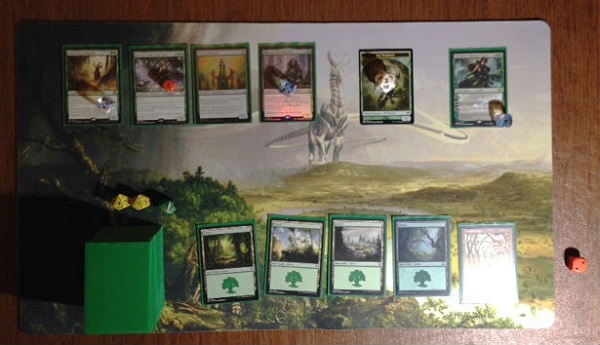
This isn't from an actual game, so I probably could have made a better effort at mocking it up, but you get the idea. You've got creatures, tokens, a planeswalker, a library, some lands and life dice. My graveyard usually goes to the left of my library. My command zone is over on the right where the orange die is.
Commander Tax
What do you do with that mulligan reminder die when you've got your starting hand?
That's an easy one - put it over by your command zone so you can use it as a Commander Tax reminder!
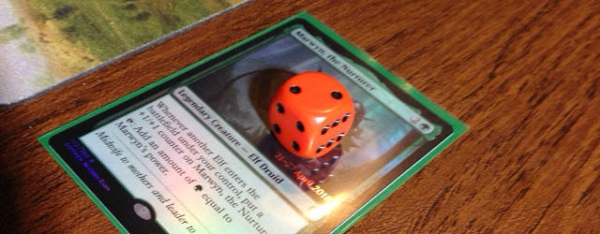
I use an orange die for my commander tax reminder, and I always set it to the amount of extra mana I have to pay to cast my commander.
I set the die aside at the start and once my Commander has been cast at least once, I'll put it on top of the card as a 2, 4 or 6 to remind me of my tax. I'll use multiple dice if I'm ever in one of those nightmarish games where I'm having to cast my commander more than four times. It's important to me that I not screw up my commander tax, but it's also important to me that my opponents can tell at a glance how much I have to pay to cast my commander. That sort of calculation comes up more often than you might think in a commander game.
+1/+1 Counters
One of the most common uses in Magic for six-sided dice is for representing +1/+1 counters. Marwyn, the Nurturer gets them when I put an Elf onto the battlefield, but lots of creatures deal in +1/+1 counters.
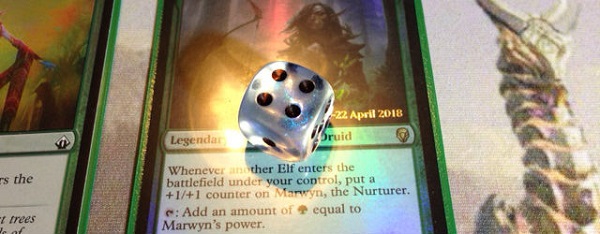
They are so commonly used for this purpose that I would actually advise AGAINST using six-sided dice for any other purpose in relation to creatures. There's no rule against using twelve-sided dice, pennies or even Skittles to represent +1/+1 counters but you'll be presenting your opponents with a clearer and more easily understood board state if you do what practically every other player is doing.
-1/-1 Counters
Once upon a time I never even thought about the need to track -1/-1 counters.
Sure, they existed in the game but it's not like anyone was playing anything that made them a frequent problem. Then Wizards of the Coast printed Hapatra, Vizier of Poisons and everything changed.
For about a year Hapatra would show up in games often enough that I decided I had to have a way to track -1/-1 counters.
The challenge was obvious. I needed to find dice that would function in the same basic way that +1/+1 counters function, but that would be distinctly different.
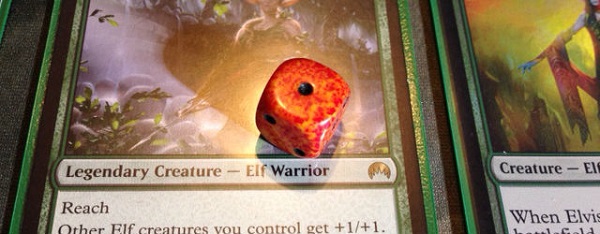
I wound up using a set of smaller six-sided-dice. They aren't tiny but they are small enough that they are clearly different.
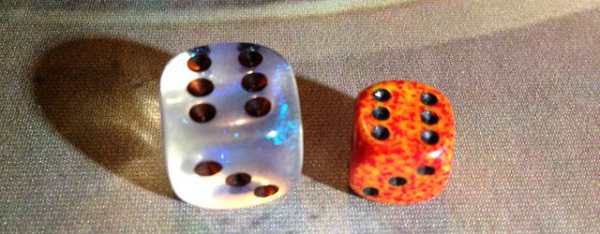
I like that the smaller six-sided dice represent counters to make a creature smaller and the bigger (normal) six-sided dice represent counters to make a creature bigger.
Quantity (not quality)
Lots of token decks generate so many token creatures that you either don't want to or simply can't use a token card for each creature.
If you're using six-sided dice to represent your +1/+1 and little ones for your -1/-1 counters, would it be confusing if you also have creature tokens on the field and you used dice to represent how many of them there are?
It would be a little confusing. That's why I always use spindown twenty-sided dice for showing how many creatures are represented by a single token card.
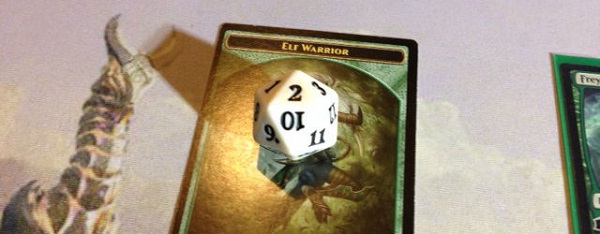
These spindown d20s are easy to find if you play Magic and if you've done enough prereleases you probably have more than you'd ever use in a game of Commander.
Life Dice
Spindown dice are supposed to be for tracking your life. You use them for your life counter in other formats so why not use them in Commander?
You can, and as long as you place them somewhere that won't lead to an opponent being confused, that's fine. You want your life total distinct and clearly identifiable to my opponents.
In Commander you start at 40 life, not 20, and it's not uncommon for a player's life to shoot up way over 40, sometimes going into the hundreds or even the thousands.
I use a set of yellow d10s that I picked up at The Portal in Bethlehem, PA.
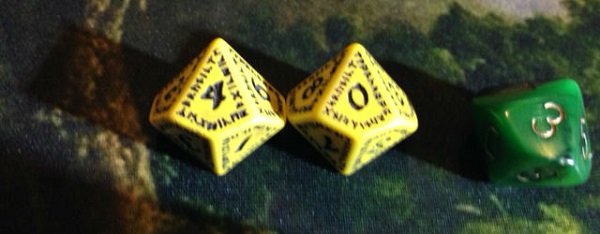
I have four of the d10s and a d8 so I can go up to 89,999 life without resorting to using other dice. They look different from my quantity, counter and tax dice and I always put them directly above my library where anyone can see them.
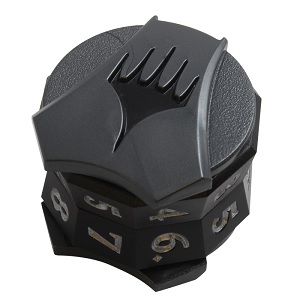 | 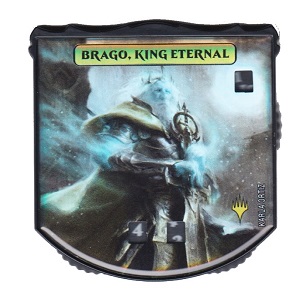 |
Another great solution is to pick up one of the new plastic life counters that Wizards has created. I've also seen players use plastic relic tokens for their life counter, but I have a hard time reading those from across the table so I don't actually like them that much. I'm not sure my yellow dice are that much easier for opponents to read but if I'm having trouble telling what someone's Relic Token is at I definitely don't want to put my opponents in the same position.
Commander Damage
Have you ever really thought about how many things need to be tracked in a commander game? As I'm writing this column it did strike me that our format is more than a little ridiculous at times.
If you get hit for 21 damage by any single commander card, even if it was under the control of different opponents at different times, you lose the game.
Because I don't want to lose track of things that might win or lose me the game, I also use dice to track commander damage. If the damage is coming from an opponent to me, I'll put the die on the edge of my opponent's playmat (unless they object) and point it so the triangle face that is on top is pointing toward me. If the damage is going from me to an opponent, I'll put it on the edge of my playmat with the triangle facing toward the opponent that the damage was inflicted on. Playmats are large enough that it's usually pretty easy to position them so that it's crystal clear which die represents damage to which opponent.
Poison Counters
Wait.. what? Poison counters? Do you really have special dice to track poison counters?
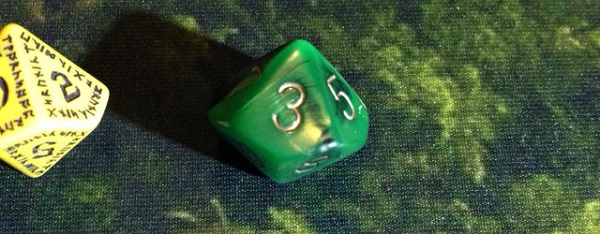
Well... yes. Once upon a time I built a Skithiryx, the Blight Dragon deck and I picked up a set of four green 10-sided dice to use for poison counters.
I wanted a color that would look nasty and unpleasant and a mottled green and black die looked just right. That deck isn't together any longer, but I still pull them out if I need to track damage from a creature with infect. Much like the commander damage dice, I place them on the edge of my playmat pointing toward the opponent who took the infect damage.
Planeswalker Loyalty Dice
I don't run a lot of planeswalkers and I don't have a super friends deck, but when I do play a planeswalker I usually use six-sided dice to track their loyalty. They probably aren't ever going to get +1/+1 counters and they also probably aren't going to need a "quantity" die, so using a d6 works well enough.
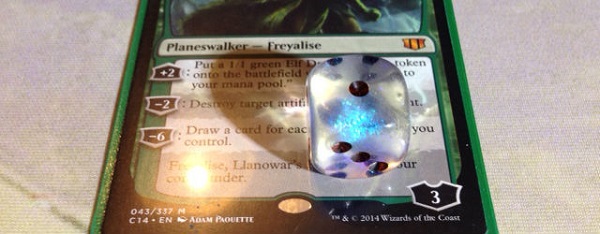
I think this is the norm for many Magic players, though I'm sure there isn't a rule requiring you to use a d6. You simply have to represent your boardstate clearly.
Ramos Dice
Moving away from my Marwyn example, I've also found excuses to pick up dice to fulfill very specific roles for very specific decks. One of my favorite commanders, Ramos, Dragon Engine, has the ability to create 10 mana if you remove 5 +1/+1 counters from him. That mana comes in the form of ![]()
![]()
![]()
![]()
![]()
![]()
![]()
![]()
![]()
![]() , or "Progenitus" mana.
, or "Progenitus" mana.
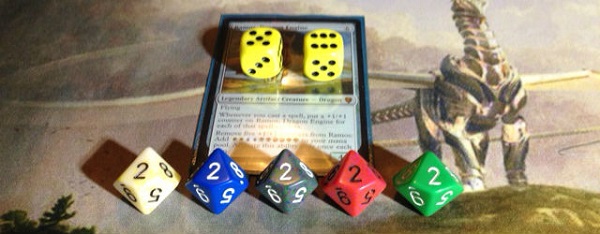
I went out and bought five ten-sided dice help let me track my mana. I picked up a white, blue, black, red and green d10 and since Ramos sometimes gets flickered and used multiple times in a turn it's nice to be able to track more than just the initial two mana of each color.
Who Goes First?
I used to roll a d20 to determine who goes first in a game, but then I encountered someone who took exception to that. A spindown d20 wasn't random enough for him. After that, I picked up a randomized twenty-sided die and have made sure to use it for rolling to see who goes first.
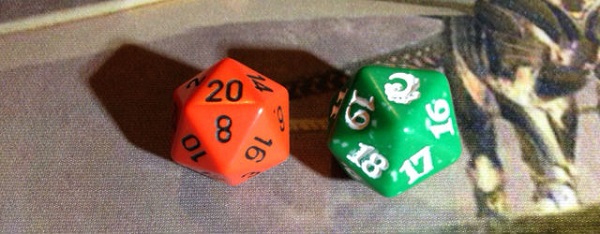
We actually have a tradition of allowing the first player to roll to decide what we're rolling and how. That has resulted in all kinds of silliness. We'll often see something like a red d20 and a white d20 and the call that the result is "red minus white". I can't imagine why anyone would want to add more math into their life, but that's what we often wind up doing. It's goofy and fun and I like having a lighthearted moment at the start to try to set the tone for the game.
Coin Flips
I have long been a fan of flipping coins when a card tells you to flip a coin. I'm aware that some might argue that a coin flip isn't as random as a die roll, but I like doing it anyways. In most casual games it seems silly to get all worked up over something as trivial as a coin flip.
For a while I had a few coins with the number "3" written on one side in black with a Sharpie marker for use as a Mana Crypt reminder. You flip a coin at the beginning of your upkeep if you control a Mana Crypt and lose the flip you lose 3 life. If I flip the marked-up coin and the "3" is on top, I lose three life. It's clear to everyone what happened and I can leave the coin on top of my library as a reminder so I don't forget.
I've spent some time looking for coins that have a "3" on them and thus far have come up with nothing. It amazes me that I haven't found any "3" coins yet. I wouldn't care if it was a 3 Pound, 3 Mark, 3 Franc, 3 Yen, or 3 cent coin - though I'd prefer something hefty. A skinny copper coin with no real weight to it might do the job but not feel great to use.
I recently came into the possession of a 2014 half dollar that is so weird that I had to start using it for my coin flips, though I won't mark it up with a Sharpie marker.
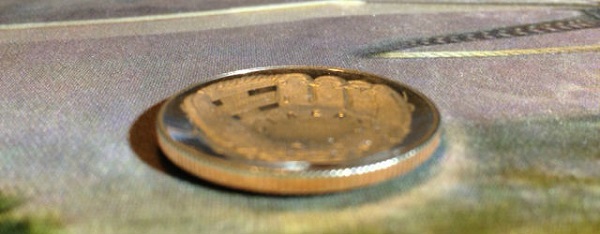
It's a commemorative baseball coin and has a baseball glove on one side, but the amazing thing about it is that it isn't flat. I'm not sure how well you can tell from the picture above, but it's slightly concave with a picture of a baseball on the convex side and a baseball glove on the concave side.
I'll probably let an opponent pick which side is the "win" when flipping it if I ever come across someone that thinks I'm trying to cheat. My guess is that it probably has a slight bias toward the concave side but that can be easily remedied by catching it in mid-air and then slapping it onto the back of your hand instead of letting it hit the table. In casual games I'm sure it won't ever be a major problem, but I'll always have other coins and dice if I'm faced with someone who decided to take exception to flipping a coin.
In regards to rolling dice in place of flipping coins - I've seen players roll dice without clearly declaring whether evens or odds meant that they lost the 3 life. I'm sure they thought they were being clear, but you really have to say what you're doing so everyone understands.
If you ever pick up a Mana Crypt or any other cards that ask you to flip a coin, I encourage you to find a coin with artwork that you love or that has some sort of positive association for you. It might be leftover change from a trip overseas or a quarter from the year you were born. You'll sometimes have opponents who want you to roll dice instead, but if you can get away with flipping coins you might as well have one you like to use.
Token Creatures
If you've played much Commander at all, I'm sure you've seen this. A player creates a creature token. They may (or may not) fumble around in their stuff looking for a card and then they just plop a six-sided die down on the battlefield to represent the creature.
No big deal, right?
The problem with this kind of laziness is simple - there's no way to tell if the creature is tapped or not.
Maybe the creature will never tap, but it's a courtesy to the other players at the table to clearly represent your board. Furthermore, you might not remember if you had tapped it or not in the time between your turn and another player trying to decide whether or not to attack you.
Creatures and Lands (a diatribe)
You knew I was going to mention this at some point.
This column was initially about dice but it is also about maintaining a clear board state.
If you're going to all these lengths to clearly represent your board state, it's not much to ask that you don't resort to childish "tricks" to try to gain an advantage in a game that most of us are just playing for fun.
Put your creatures in front of your lands like everyone else.
It's not that hard and you don't really need to be different in that way. Maybe try building an interesting deck.
Don't put the Dryad Arbor that looks like a Forest in amongst your lands. Just don't.
Also don't put your Maze of Ith under some other lands in your stacks of land cards because you're ramping so much that your lands have to overlap each other.
"Winning" like that, through tricking people by misrepresenting your board state and trying to sow confusion in the minds of the people you're playing with makes you more of a loser than anything else. Even if you're doing something that might be permissible in the rules, if you're trying to make your board state harder for your opponents to understand, I suspect you're playing a casual format for the wrong reasons.
The Upside
Do you need to go to these lengths to keep accurate track of everything you've got going on in your Commander game?
Of course not. Commander is a casual format and ultimately what matters is that you and your friends are having fun and playing by the rules.
Is there an "upside" to having a consistent approach for how you represent and track your board state, life total and all the other things we need to know in a game of Commander?
Absolutely.
When you are clearly putting effort into playing an honest and accurate game of Magic, it engenders a certain amount of trust.
We've all played with or heard about players who were a little too fast and loose with the rules. Maybe you're like me and you are generally oblivious to such things. I'm something of a trusting fool, and could probably have someone outright cheat and I might not even notice. Maybe you're the opposite and you keep a keen eye on what everyone is doing and are quick to assume that someone is trying to pull one over on you.
However you approach the game, I would hope that you care about your opponents thinking that you are trustworthy and honest. You can't control what other players think of you, but by maintaining a clear board state can show everyone that you do care about not confusing them unnecessarily. It might seem like a small thing, but it makes a difference and will help to engender trust. Getting favors and making deals in Commander isn't always easy, but it's a lot harder with someone who isn't sure whether or not to trust you.
Final Thoughts
I had planned to write about Heidar, Rimewind Master today, but I'm putting that off for a week so I can get another game in with the frosty b*stard. His first game saw a lot of drawing and passing the turn and not really doing anything until someone caught me with my lands tapped. I'll definitely share my Heidar deck next week and apologies to any of you who had been looking forward to reading about him today.
I really do think that this new London Mulligan is going to result in a little more confusion than Vancouver or Partial Paris, and I do think that using a die to track your mulligans is a smart thing to do. That doesn't mean I think the London Mulligan is terrible - just that there will be folks who lose track of where they were as they're doing it.
Was that kernel of a thought enough to warrant devoting a whole column to how I try to keep track of my board state? I guess that's up to you, dear readers. If you come away from today's column with some new ideas on how to play the game and you go buy some fancy new dice, that's awesome. If you've got some other way to track your game, feel free to let me know in the comments. I'm always open to new ideas and many of you have been playing for much longer than I have.
That's all I've got for today. Thanks for reading and I'll see you next week!

























